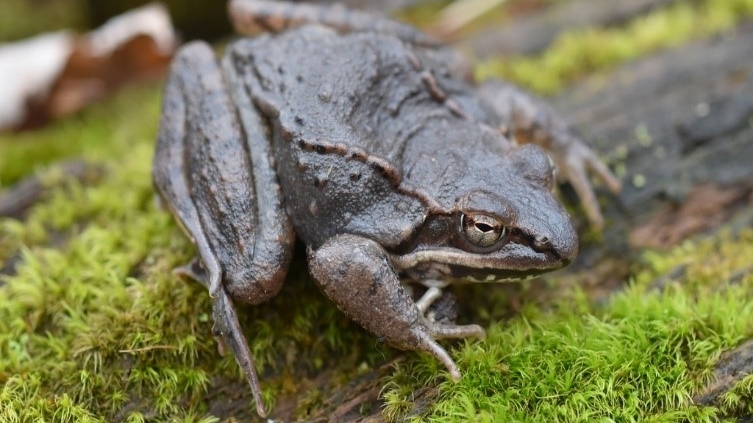Near to Nature: Frozen Frogs of Bays Mountain
This article, published in the Spring 2021 edition of “The Interpreter,” was contributed by ETSU Roan Scholar Cade Campbell.
As the first warm, spring rains settle into Tennessee, they bring with them a new chapter of life for our forest ecosystems: Wood Frogs. Almost invisible, camouflaged in crunchy, winter leaf litter, these bizarre amphibians are awakening across the mountains. They begin to thaw and start a long and intense journey, over snow and across hard, frozen ground in February. Each of these frogs, virtually unnoticeable on the moss-covered forest floor, has one goal in mind. They must return to the place where they were born to lay eggs or die trying.
The Wood Frog (Lithobates sylvaticus) lives deep in the upland woods. Instead of sticking around peaceful ponds or swamps year-round like their relatives, wood frogs must migrate to “vernal pools” in late winter to find suitable habitat for their eggs, which hatch into fully aquatic tadpoles. These pools fill up in the spring rains and completely dry by midsummer, reverting to simple forest floor. All kinds of frogs, toads, salamanders; even fairy shrimp and many insects use these ephemeral wetlands. But they must make use of them quickly.
On their journey, wood frogs have no way to escape freezing temperatures by digging underground with only spindly legs meant for jumping. They also cannot generate their own body heat like a “warm-blooded” mammal or escape deep underwater like other native frogs. Instead, they have glycogen antifreeze naturally coursing through their blood. Just like antifreeze in a car, the antifreeze inside wood frog blood helps keep its body functioning even when the frog is frozen! This allows the species to range north to Alaska. Right here on Bays Mountain, one of the toughest frogs in the world thrives. Since they have such an extreme life cycle, wood frogs have little competition from other species. Those that survive the harsh environment often find plenty of suitable habitat, tasty insects, and more peaceful vernal pools.
The smaller male frogs arrive to the pools first, floating in the center. Rather than sitting on the shore and inflating a throat pouch to amplify their calls, wood frogs have two armpit pouches they inflate to make duck-like croaks. These crackling, otherworldly echoes fill mountain forests early in the spring, and dozens of frogs may cram into one tiny puddle along the trail or a forest road. The males are smaller than females and sooty-brown, females are often bright, amber orange. Both shift to varying shades of leathery tan when they return to dry land, reverting to their camouflage coloration. Wood frogs have two crest-like folds of skin running down their back, and they have black-and-white masks across their face. These are two helpful identification factors, but there are few frogs that look and behave like this species.
They leave behind massive, gelatinous blobs of transparent eggs, each with a tiny, black embryo. These embryos slowly begin to develop into tadpoles, as the spherical dot begins to grow and unfold into a tail and miniature body. Soon, the wood frog tadpoles emerge, and begin eating any remaining yolk. This yolk lasts for most of the spring, feeding the tadpoles as they turn into gold-flecked, fish-like swimmers. Hundreds will initially be seen basking at the surface of vernal pools, but by early summer raccoons, red-spotted newts, herons, and many other animals will gradually deplete the population. Luckily, the constant threat of predators is why the mother frogs lay so many eggs; without many siblings, one frog has very little chance of surviving. By late summer, the tadpoles will grow legs, gain the adult coloration, and hop away to their own patch of seclusive woodland.
Wood frogs roam the woods freely and in abundance, so no matter where you might be strolling or hiking on the mountain, one could always be hiding nearby. Every sign of these unique animals in the beautiful springtime forest is a rewarding find, so keep an eye (or an ear) out for them while venturing down the trail!







